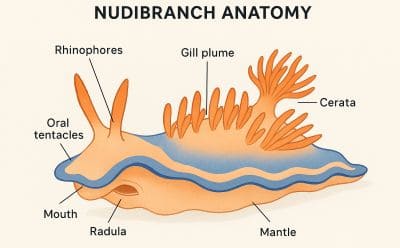Home › Sea Wildlife › Marine › Invertebrates › Mollusks › Nudibranchia › Anatomy
Interesting Facts about Sea Slug Body Parts
No matter whether you call it a nudibranch or a sea slug, they both belong to a diverse group of marine gastropod mollusks noted for their intricate forms and vibrant colours.
This page explains how the internal and external anatomical features of nudibranchs function, with details about a few special adaptations that help them crawl over the ocean floor.
What is the Basic Anatomy of a Nudibranch
The order Nudibranchia contains over 3,000 soft-bodied creatures that lack any kind of protective shell.
It's also reflected in their scientific name, loosely meaning 'naked gills'.
But the anatomy of a nudibranch is uniquely adapted to life in oceanic environments, featuring:
- A muscular foot (for movement)
- External gills (for respiration)
- Rhinophores (for sensory perception)
Nudibranchs exhibit a fascinating range of shapes, sizes, and coloured patterns. In fact, they use their aposematic colouration as camouflage and as warning signals to oblivious, or ignorant, predators.
It's a complex combination of specialised anatomy that also includes an array of feathery rosette appendages that help with breathing and defence.
Nudibranch Anatomy: External
Nudibranch Rhinophores
With the exclusion of a small group of sea slugs, all nudibranchs have a pair of 'horn-like' sensory tentacles on the head.
The main function of these chemosensory organs is to help them detect chemicals in the water. Thus, rhinophores are capable of locating food, detecting a partner for reproduction, and 'sniffing' danger to avoid predation.
Plus...
Most of the nudibranch species also have a pair of oral tentacles near the mouth that help them identify food, such as barnacles and sea sponges, by touching and tasting it.
Fun Fact: Some nudibranchs can retract their rhinophores into sheath-like pockets as a means of protection. It's a common defence mechanism that helps to prevent their main predators (wrasses and crabs) from damaging these key sensory organs.
Gill Plumes
The branchial plume is a cluster of feathery gills seen on the dorsal side of dorid nudibranchs, usually close to the rear.
They often appear as feather-like tufts, but the main function of these 'branching structures' is to absorb oxygen directly from seawater.
The gill plumes are replaced by cerata in aeolid nudibranchs. Whereas, the plume tends to be more exposed (and retractable) in dorid species.
Cerata (aeolid nudibranchs)
Some species have finger-like projections (called cerata) on the back. Not only do they create extra surface area for gas exchange (respiration) they can also store nematocysts (stinging cells) from their prey, such as hydroids and sea anemones.
 Some extensions of the digestive gland that also run through the cerata help to process nutrients.
Some extensions of the digestive gland that also run through the cerata help to process nutrients.
In fact, some species use cerata as a form of solar energy, by storing chloroplasts from algae (a process called kleptoplasty).
Muscular Foot
In nudibranch sea slugs, the flattish muscular underside is used for movement, more like a 'gliding' locomotion, that leaves a secretion of mucus in its path.
Nudibranch Mantle
The main colouration comes from the pigments housed in the upper body surface (mantle) and a type of skin that covers most of the dorsal area.
Moreover, the mantle is the place where these marine gastropod molluscs store distasteful chemicals or toxins as a kind of defencive mechanism.
Mouth and Radula
The mouth of a nudibranch is located underneath the head with a toothed radula (a ribbon-like structure) used for feeding. They use their radula to stab or scrape their favourite sources of food - bryozoans, hydroids, coral polyps, and sponges.
Nudibranch Anatomy: Internal
Digestive Gland and Nervous System
The digestive gland (hepatopancreas) processes their food and it sometimes extends into their cerata for further digestion and storage.
As with many ocean invertebrates, the primary function of a centralised network of fused ganglia is coordinating movement and sensory input.
Reproductive Organs
Because all nudibranchs are hermaphrodites, each individual contains male and female reproductive organs. So, copulation usually involves a careful alignment of the right hand sides to exchange sperm.
Heart and Circulatory System
Even though some nudibranchs don't have a heart, the ones that do use it to circulate the blood-like fluid called 'hemolymph' around the body. As already mentioned, oxygen exchange and respiration occurs at the gills or the cerata.